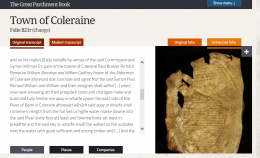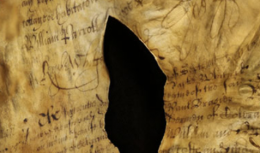More stories from the Great Parchment Book: Paul Brasier and Coleraine wharf
Next » « PreviousThere are lots of stories just waiting to be discovered in the reconstructed pages of the Great Parchment Book. Colin Salter has found information about his ancestor, Paul Brasier who first brought the Brasier family to Ireland and was involved in the building of a riverside wharf in Coleraine.
 Paul Brasier arrived in Ulster in 1611 as part of part of the Plantation of James I and settled in Coleraine. His name occurs several times in the Great Parchment Book, principally as a member of a consortium commissioned by the Crown to build a riverside wharf in Coleraine. The book records in some detail the terms and conditions of the commission. The wharf must be a minimum size “from the full sea or high water mark down into the said river sixty foot at least and twenty foot at least in breadth, and the said quay or wharf shall be walled on the outsides next the water with good, sufficient, and strong timber” and the consortium must not use cheap materials; they “shall laid forth and expend in and about the building and making of the said wharf forty pounds sterling at the least.”
Paul Brasier arrived in Ulster in 1611 as part of part of the Plantation of James I and settled in Coleraine. His name occurs several times in the Great Parchment Book, principally as a member of a consortium commissioned by the Crown to build a riverside wharf in Coleraine. The book records in some detail the terms and conditions of the commission. The wharf must be a minimum size “from the full sea or high water mark down into the said river sixty foot at least and twenty foot at least in breadth, and the said quay or wharf shall be walled on the outsides next the water with good, sufficient, and strong timber” and the consortium must not use cheap materials; they “shall laid forth and expend in and about the building and making of the said wharf forty pounds sterling at the least.”
 In return for building this commercial asset to the town, the consortium could run and develop the quayside facilities “at their proper costs and their dues, to make, erect, build, and fully finish one crane and cranehouse on any such part of the aforesaid wharf as shall be most convenient” and thereby, it was to be hoped, make their money back; they “shall have and hold all profits, commodities, duties, and payments belonging to the said quay, wharf, and crane for the term of one and twenty years from the feast of Phillip and Jacob now last past, for and under the yearly rent of forty shillings sterling for the last twenty years of the said one and twenty years payable unto his Majesty, his heirs and successors.”
In return for building this commercial asset to the town, the consortium could run and develop the quayside facilities “at their proper costs and their dues, to make, erect, build, and fully finish one crane and cranehouse on any such part of the aforesaid wharf as shall be most convenient” and thereby, it was to be hoped, make their money back; they “shall have and hold all profits, commodities, duties, and payments belonging to the said quay, wharf, and crane for the term of one and twenty years from the feast of Phillip and Jacob now last past, for and under the yearly rent of forty shillings sterling for the last twenty years of the said one and twenty years payable unto his Majesty, his heirs and successors.”
So the King took his cut, but Paul Brasier and his partners were hoping to profit by doing business with the new regime. It is certainly true that, at the same time that disillusioned settlers were leaving the plantation, the Brasier family’s land holdings began to increase. In 1649, he received a further grant of land in Ulster, presumably not from Charles I who had been beheaded in January that year, but from Charles’ executioner Oliver Cromwell. It is tempting to speculate that Paul was being rewarded in the aftermath of the massacres of Protestant settlers in the Irish uprising of 1641 – an uprising which another ancestor, Hugh Massy, helped to suppress – but that’s another story.
Find out more about Paul Brasier and Hugh Massy by following the links at http://talltalesfromthetrees.blogspot.co.uk/2015/07/paul-brasier-active-1611-1649-and.html.
You can read the story of another settler, George Canning, the Ironmongers’ Company’s first agent at http://www.greatparchmentbook.org/2016/10/03/the-ironmongers-companys-initial-period-in-ireland/.
There must be lots of other stories out there about people in the Great Parchment Book – if you know one, please let us know!